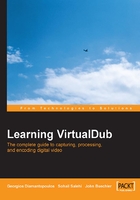
Downloading and Installing VirtualDub
The download is a zipped package of size less then a megabyte. Get it from the official website at http://www.virtualdub.org/, or for v1.6.0 from this link at SourceForge.net: http://prdownloads.sourceforge.net/virtualdub/VirtualDub-1.6.0.zip?use_mirror=optusnet. The file name includes the version number, so your downloaded file will be something like VirtualDub-1.6.0.zip.
Install by extracting the zipped files to any folder. An installation process isn’t required. You can use WinZip to extract files from the zipped package, available from http://www.winzip.com/.
Be sure to tell the unzip utility to include folders in the unzip operation as some of the files need to be in their own folder. The following figure shows the files and subfolders you’ll have:

One of the subfolders is named plugins. This contains all filter files. Let’s drill down into it and install a few filters.
Additional Filters
You can download and add additional filters to the 30 included in the basic VirtualDub software. They are available from Donald Graft’s website at http://neuron2.net/.
Load a VirtualDub filter manually by clicking on the Load button that appears in the Add Filters dialog box. You can also have them automatically loaded at the startup of VirtualDub by copying the .vdf files into the plugins subfolder.
A few of the available filters are:
- Deshaker: Takes the unplanned shakes out of your recorded footage. Download the
Deshaker.zipfile from http://home.bip.net/gunnart/video/Deshaker.zip and copy thedeshaker.vdffilter file to the plugins folder. - Subtitler: Overlays text on a video. The text is defined in an SSA script file. You can use different size fonts, colors, and positioning.
- Delogo: Removes an embedded logo or timestamp by changing the selected area such that the pixels blend into the surrounding ones. The filter is available from http://neuron2.net/delogo132/delogo.html.
- Warpsharp: Tightens edges in an image by warping the image toward edge boundaries.
Filters have an extension of .vdf (VirtualDub filter). The following figure shows a few of them in the plugins folder:

Copying the filter file from a downloaded zip file to the plugins subfolder is all that is needed to use it. The delogo filter comes with a complete instruction manual,
which we’ve placed in a delogomanual subfolder.
The next figure shows the delogo filter being applied to remove the time stamp from a video that inadvertently included it in the recording. Not only was it in the video, but the monorail in Seattle was running on Pacific Time while the camcorder was on Eastern, so it was three hours off:

It’s unusual but possible for filters to conflict with each other. If you have problems with a particular group of filters, check them individually and change the sequence they are applied in.
VirtualDub Source Code
If you’re curious about the source code and how VirtualDub works, or want to try your hand at developing it further, the source code packages are a download away, in files packed using the bzip2 block-sorting compressor. The links to the latest stable and developmental releases are:
http://prdownloads.sourceforge.net/virtualdub/VirtualDub-1.6.0-src.zip.bz2?download
http://prdownloads.sourceforge.net/virtualdub/VirtualDub-1.6.3-src.zip.bz2?download
You can extract the files from the 1+ MB packages using a utility such as WinRAR, available from http://www.rarlab.com/.
This codebase will build both normal and P4 versions. All tools necessary to build the release executable and help file are included (verinc, mapconv, disasm, and Lina).
You’ll need Microsoft Visual C++ 6.0 Service Pack 5 + Processor Pack or later to build the general release, and Intel C/C++ 6.0 or later to build the P4 version.
And, as with other aspects of VirtualDub, the source code to study how the filters work or develop them further is also available for download.